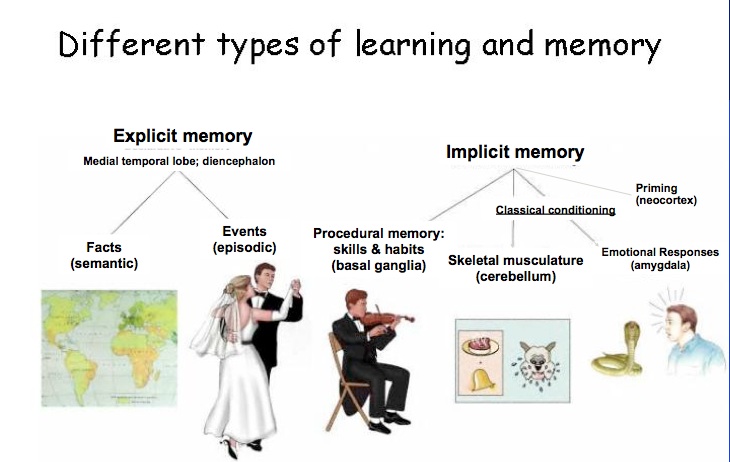
PSYC 2: Biological Foundations - Fall 2012 - Professor Claffey
Version:
11/18/12 - original version

A note on memory classifications
Definitions developed from observing behavior and trying to classify memories accordingly
These definitions could sometimes be fuzzy (e.g. semantic versus episodic)
As we understand more about the brain, can classify according to necessary _______________
_____________ memory
Examples: Obama is president, PSYC 2 is in Price Center Theater, my 21st birthday was a disaster
facts (_____________), experiences (_____________), locations
conscious and explainable (you can be explicit about the memory)
_____________ memory
Examples: how to tie a shoe lace, the steps to get from your bed to the bathroom, fear of spiders
skills, routines, emotional memories
subconscious and not easily explained
An experience might lead to both explicit and implicit memories
You might be afraid of spiders and be able to explain when you formed this memory
But the explicit/implicit components of that memory will be handled differently (see below)
H.M. had bilateral medial temporal lobe lesions for epilepsy in 1953
Studied by Scoville (surgeon) & Brenda Milner (psychologist) in 1957
He was a pivotal case study that changed our understanding of memory
Post surgery:
well-adjusted, sensory & motor intact, high intelligence, short term memory intact
didn't have memories for events up to 2 years before surgery, but older memories intact
could NOT form new memories such as address, why he's in the hospital, people he met
Died in 2008, brain donated to and digitized by UCSD's Brain Observatory
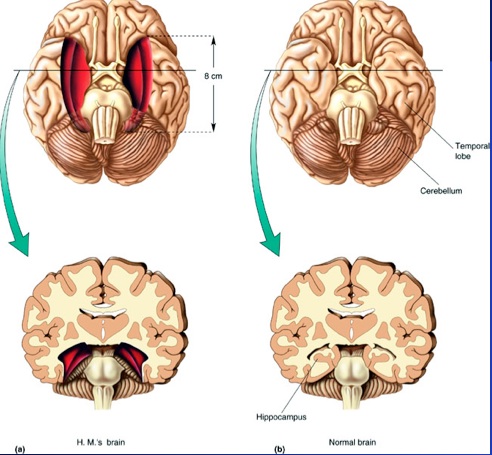
|
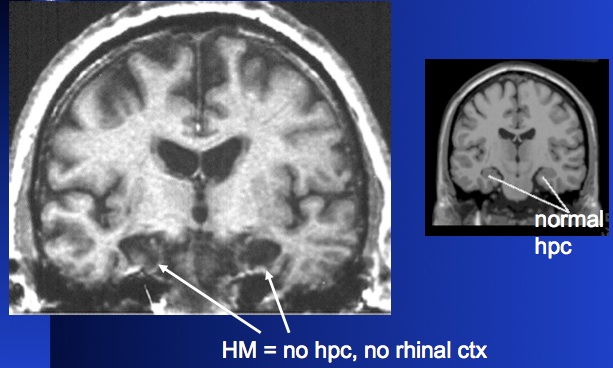
|
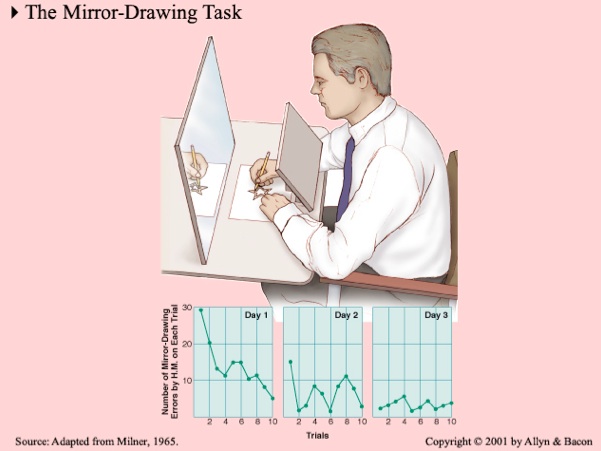
|
Mirror Drawing Task: trace a shape with a pencil through a reflection in a mirror Result: HM initially made many errors (similar to normal subjects) but improved each day HM had no memory of the task or his improvement Summary: HM was capable of learning a skill without being aware of his ability (_____________ learning) |
Video on amnesiac E.P. (youtube, 1:34 - 9:30)
Herpes enchephalitis
Charismatic, intelligent, able to reason & problem solve, short term memory (like word lists) intact
Could not permanent store short term memories, remember people, learn address
Video (3 mins)
An accomplished symphony conductor
Herpes enchephalitis
Deficits:
Couldn't remember own children's name
Only a few seconds of short term memory
Constant sensation of having just become conscious for the first time in his life
Intact:
Still strongly loved his wife (an emotional memory)
Play piano, conduct symphony, name a few composers, learn habits in his supportive care home
Damage to hippocampus and surrounding areas
stroke
herpes enchephalitis - herpes simplex-1 (cold sores) viral infection of the central nervous system
Korsakoff's Syndrome - severe alcoholics
surgery - tumors/epilepsy treatment, bilateral removal of medial temporal lobe are now avoided
Alzheimer's disease
changes throughout the brain that also affect hippocampus
made worse by dementia - patients
tend to be confused, so memories are less clear to begin with
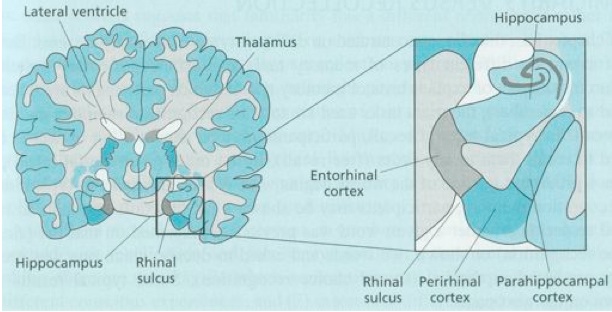
|
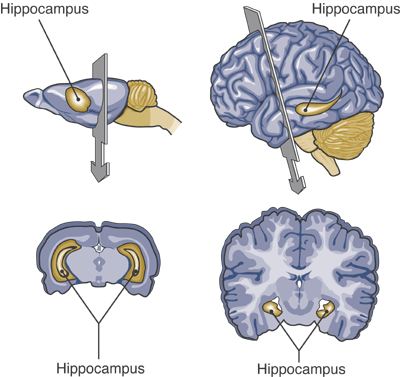
|
_________________ amnesia - can not form memories AFTER the event
_________________ amnesia - loss of memories formed BEFORE the event

Source: Haist et al, 2001 |
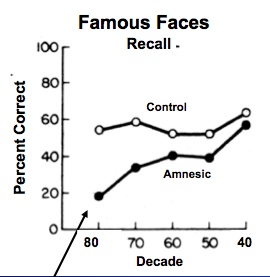
|
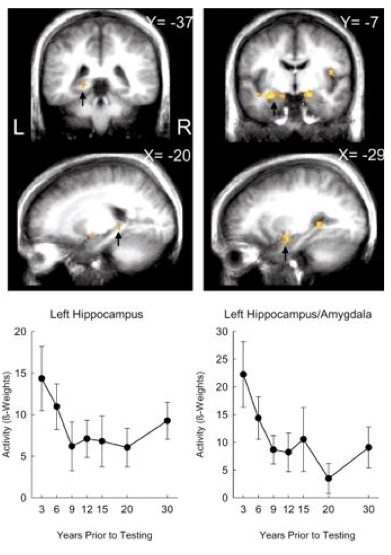
|
Source: Smith & Squire, 2009 Task: Result: Summary: |
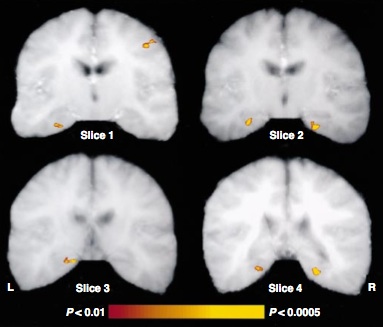 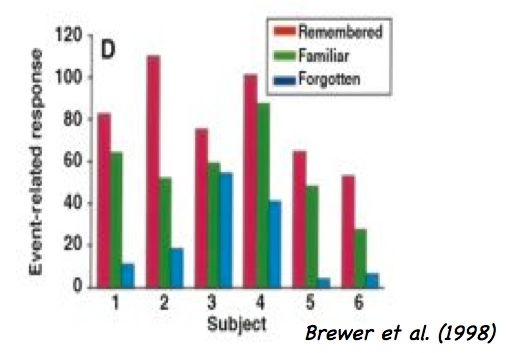 Source: Brewer et al, 1998 |
Task: The brain does not capture all incoming information equally
|
Task:
Rat/mouse spends time in a small chamber where it receives an aversive foot shock (training)
Shock is delivered at the same time a tone plays
Days later, animal is returned to chamber to measure amount of time that the animal freezes (__________)
Results:
Animal will freeze if returned to identical box (__________ test), even without playing the tone
Animal will freeze if returned to a differently configured box if the tone is played (__________ test)
Summary:
Freezing measures fear, which is a form of memory
Memory is simultaneous formed for the place (context) and the tone
This basic memory is formed easily/quickly and animal will remember for its life time
This task can be used to study behavior, but also what is going on in the brain to form this simple memory
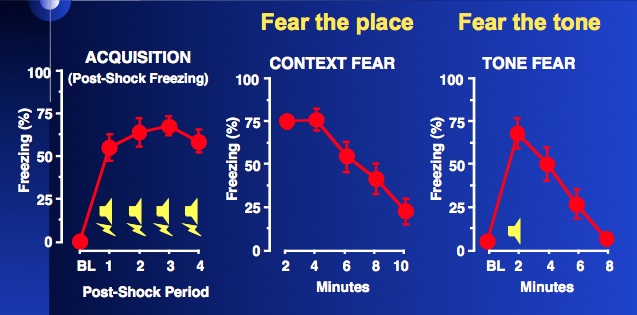
Questions:
Does the context memory depend on the hippocampus?
Does this dependence on the hippocampus change with time?
Task:
same as fear conditioning above
4 different treatments
some animals have their dorsal hippocampus (DH) lesioned 1 day after training (Recent)
some animals have a fake lesion procedure (Sham) 1 day after training (Recent)
some animals have their dorsal hippocampus (DH) lesioned 30 days after training (Remote)
some animals have a fake lesion procedure (Sham) 30 days after training (Remote)
Result:
animals given a sham/fake lesion have a good memory for context and freeze about 75%
regardless of when procedure is performed ("Context Summary" graph, yellow line)
this condition is done as a control
if the hippocampus is lesioned when training is Recent, animal loses memory of training
and doesn't freeze in the context test ("Context Summary" graph, lower right red dot)
if enough time is given after training, hippocampus lesion doesn't affect content memory
("Context Summary", upper left red dot)
hippocampus lesion does not affect freezing to tone ("Tone Summary" graph)
Summary:
hippocampus is only necessary for remembering the context immediately after training
with time, the memory must ___________________ on another part of the brain
Strong evidence for the ________________________ seen in human amnesia
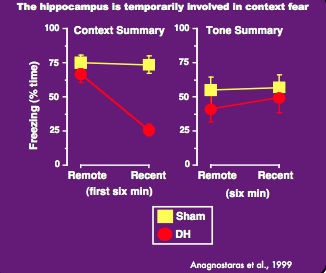
Question:
Do you have to make new proteins in order to make (consolidate) a long term memory?
Cell biology background:
Cells make new proteins by assembling amino acids based on DNA
Anisomycin is a drug that interferes with this assembly so that cells temporarily can't make any new proteins
Task:
Same as fear conditioning above
Prior to training, animals are injected with anisomycin to prevent protein synthesis
Result:
Animals injected with anisomycin do/do not freeze during the task training
This is considered short term memory (STM) in the graph below
Animals injected with anisomycin do/do not freeze after an extended delay
This is considered long term memory (LTM) in the graph below
Summary:
Animals can learn and form a short term memory even if anisomycin is injected.
However, because they can't make proteins, they can't ________________ a permament memory
Protein synthesis is necessary for forming long term memories

Question:
Once learned, are memories stable? Can they be unlearned?
Task
Same as fear conditioning above (no injection of anisomycin yet)
After training, the memory is reactivated by re-exposing the animal to the context
Some animals have anisomycin injected prior to re-exposure
Days later, animals are returned a 3rd time (1st for training, 2nd for re-exposure, 3rd for testing)
Results:
All animals freeze the same during the re-activation (PR-STM = post reactivation short term memory)
Animals that had anisomycin during the reactivation had their memory destroyed (PR-LTM)
Summary:
A reactivated memory requires another round of
protein synthesis to _________________ it, or the memory will be lost
Source: Nader & Hardt, Nature Reviews Neuroscience, 2009
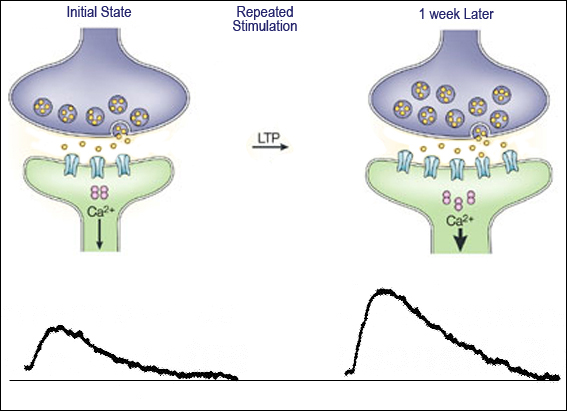
|
this is the process by which memories are formed at the level of the neuron/synapse also called "Cellular Consolidation" Strengthening existing synapses (new receptors) and creating new synapses (new neuron structures) requires __________________________ Takes place over a time scale of minutes to hours |
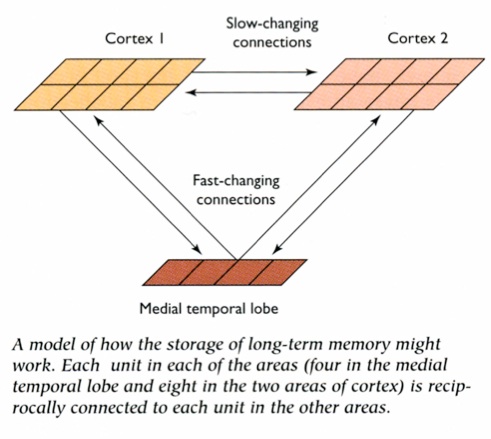
|
Theory: Hippocampus has _________, adaptive connections to learn quickly Cortex has _________ changing connections to maintain knowledge useful or frequently encountered Summary: memory is initially in hippocampus (or hipp. points to memory)
Takes place over a time scale of days to years
gradually strengthens in the cortex until hipp. no longer needed |
Task:
Mice learn to swim around a tub of water to find a hidden platform
After training, some animals have cortex lesions, some have hippocampus lesions
Results:
With training, animals learn to swim directly to the location of the hidden platform
With enough time to consolidate, animals with hippocampus lesions can/can not do the task
Summary/Theory:
Hippocampus is strongly involved in ____________ memories and always necessary for ____________
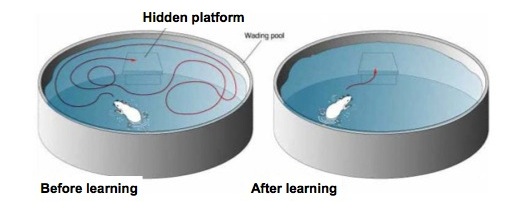

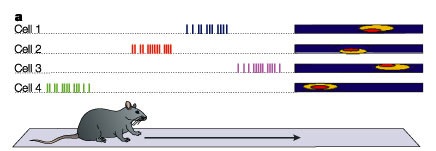 Source: Nakazawa... & Tonegawa, 2004 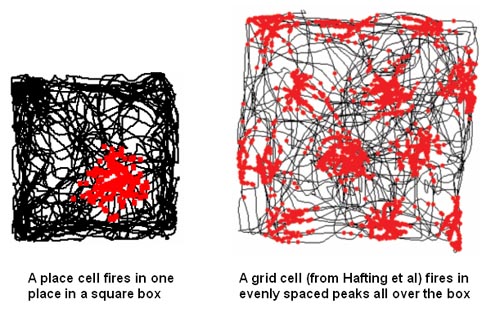 Source: www.ucl.ac.uk/jefferylab/research |
Task: Rodents have electrodes implanted to measure from hippocampus Rodents are allowed to freely roam in an enclosed area Results: Some neurons in the hippocampus reliably fire whenever the animal is in a certain location (__________ cells) Other neurons respond in many, grid like locations (_________ cells) Summary: Individual hippocampus neurons "lock on to" or represent specific locations Together, these neurons make-up a ___________________ of space |